各种时态的主动、被动语态结构表
- 格式:doc
- 大小:45.00 KB
- 文档页数:3
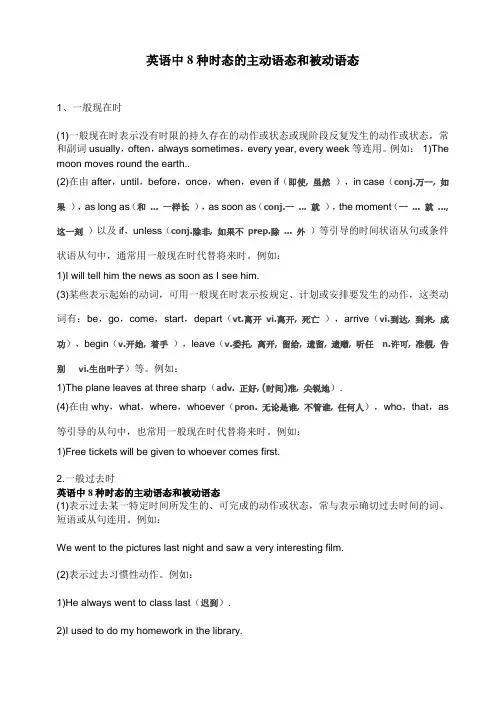
英语中8种时态的主动语态和被动语态1、一般现在时(1)一般现在时表示没有时限的持久存在的动作或状态或现阶段反复发生的动作或状态,常和副词usually,often,always sometimes,every year, every week等连用。
例如:1)The moon moves round the earth..(2)在由after,until,before,once,when,even if(即使, 虽然),in case(conj.万一, 如果),as long as(和 ... 一样长),as soon as(conj.一 ... 就),the moment(一 ... 就 ..., 这一刻)以及if,unless(conj.除非, 如果不prep.除 ... 外)等引导的时间状语从句或条件状语从句中,通常用一般现在时代替将来时。
例如:1)I will tell him the news as soon as I see him.(3)某些表示起始的动词,可用一般现在时表示按规定、计划或安排要发生的动作,这类动词有:be,go,come,start,depart(vt.离开vi.离开, 死亡),arrive(vi.到达, 到来, 成功),begin(v.开始, 着手),leave(v.委托, 离开, 留给, 遗留, 遗赠, 听任n.许可, 准假, 告别vi.生出叶子)等。
例如:1)The plane leaves at three sharp(adv. 正好, (时间)准, 尖锐地).(4)在由why,what,where,whoever(pron. 无论是谁, 不管谁, 任何人),who,that,as 等引导的从句中,也常用一般现在时代替将来时。
例如:1)Free tickets will be given to whoever comes first.2.一般过去时英语中8种时态的主动语态和被动语态(1)表示过去某一特定时间所发生的、可完成的动作或状态,常与表示确切过去时间的词、短语或从句连用。
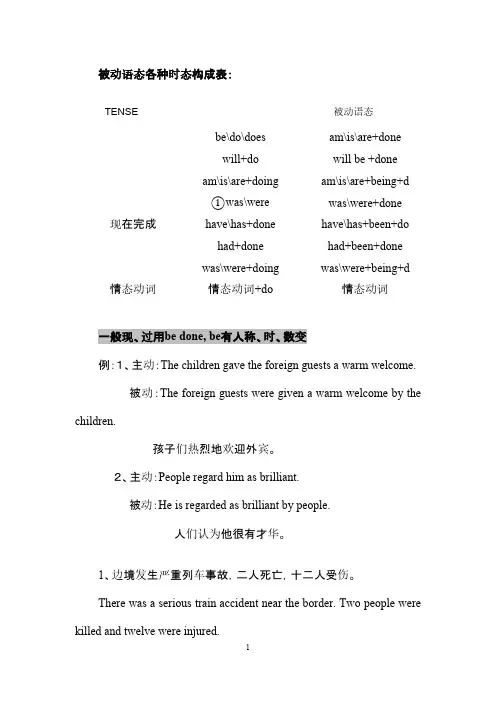
被动语态各种时态构成表:TENSE被动语态be\do\does am\is\are+donewill+do will be +doneam\is\are+doing am\is\are+being+d①was\were was\were+done现在完成have\has+done have\has+been+dohad+done had+been+donewas\were+doing was\were+being+d 情态动词情态动词+do情态动词一般现、过用be done, be有人称、时、数变例:1、主动:The children gave the foreign guests a warm welcome. 被动:The foreign guests were given a warm welcome by the children. 孩子们热烈地欢迎外宾。
2、主动:People regard him as brilliant. 被动:He is regarded as brilliant by people.人们认为他很有才华。
1、边境发生严重列车事故,二人死亡,十二人受伤。
There was a serious train accident near the border. Two people were killed and twelve were injured.2、直言不讳的人才是真正诚实的人。
A person who is truly honest is called a straight arrow.3、有人给讲演者递上来一张纸条。
A note was passed up to the speaker.4、John被选为班长而代替了亨利。
John was elected president of the class instead of Harry.5、这位战士牺牲了,然而列车得救了。
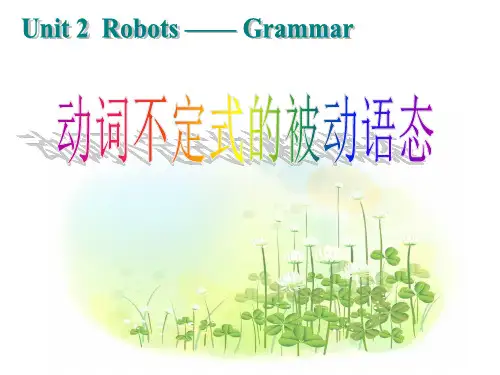
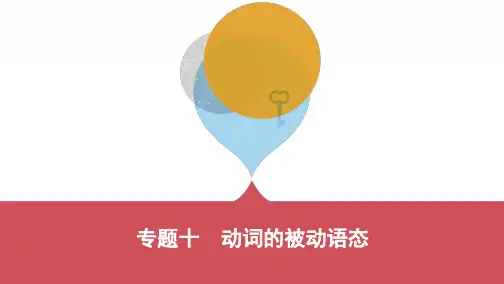
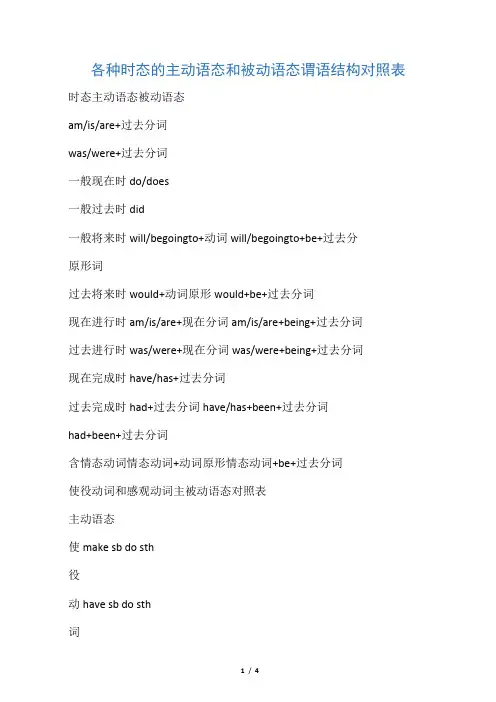
各种时态的主动语态和被动语态谓语结构对照表时态主动语态被动语态am/is/are+过去分词was/were+过去分词一般现在时do/does一般过去时did一般将来时will/begoingto+动词will/begoingto+be+过去分原形词过去将来时would+动词原形would+be+过去分词现在进行时am/is/are+现在分词am/is/are+being+过去分词过去进行时was/were+现在分词was/were+being+过去分词现在完成时have/has+过去分词过去完成时had+过去分词have/has+been+过去分词had+been+过去分词含情态动词情态动词+动词原形情态动词+be+过去分词使役动词和感观动词主被动语态对照表主动语态使make sb do sth役动have sb do sth词let sb do sthsee sb do sth感观watch sb do sth动词hear sb do sthnotice sb do sth被动语态sb be made to do sthsb be had to do sthsb be let to do sthsb be seen to do sthsb be watched to do sthsb be heard to do sthsb be noticed to do sth①Lily writes many letters every day.(主动)②Th ey visited this farm last year.(主动)③We have learned 3000 English words so far.(主动)Fill in the blanks with the Passive Voice1、Tea_______(grow) in Fujian.2、Chinese__________(speak) in China.3、The bed__________(use) for sleeping.4、Ourclassroom _________(clean) everyday.5、The cars__________(make) in Beijing.6.We will build a new lab.A new lab ____ ____ _____.(主动变被动)7. The blackboard was ________ (look) carefully by the students.8 The ship model ____ be ____ (make)in two days.1.An exhibition of paintings ____ at the museum next week.A.are to be heldB. is to be held C. are holding D.will be held2. I’m sorry,sir.Your recorder isn’t ready yet.It ____ in the factory.A.is being repairedB is repaired C. has been repaired Dhasn’t been repaired3. A lot of people in China can speak English now .(同上)English ______ ____ ______ by a lot of people in China now.4. I have learned English for about two years.(同上)English ______ ______ ______ for about two years.5. They will publish these story-books next month.(同上)These story-books _____ _____ _____ next month.6.Peoplethereplantedmanytreeslastyear.Trees__________by people there last year. (青岛市中考题)7. Theygrowvegetables on the farm.The vegetables_____________on the farm(上海市中考题)8.Our school _________in 2002.(开办)9.The young trees must____ ____ ______well.(照顾)10. _____ this building_________(建成)last year?11.The book _____ _______(写)by him last year.12. The bridge _______ _______(不建造)in1989..13.The 29th Olympic Games will____ ______(举行) in UK in 2012.14. He gives me a ring.I _____________ a ring ____ him.15. Jack made his little sister cry again.His sister _________ ____ cry again.1.被动语态练习() 1 The People's Republic of China __ on October 1, 1949.A. foundB. was foundedC. is foundedD. was found() 2 English ____ in Canada.A. speaksB. are spokenC. is speakingD. is spoken() 3 This English song___ by the girls after class.A. often singsB. often sangC. is often sangD. is often sung() 4 This kind of car ___ in Japan.A, makes B. made C. is making D. is made() 5 New computers ___ all over the world.A. is usedB. are usingC. are usedD. have used() 6 His new book___ next month.A. will be publishedB. is publishingC. is being publishedD. has been published()7 The sports meet ___ be held until next week.A. didn'tB. won'tC. isn'tD. doesn't。
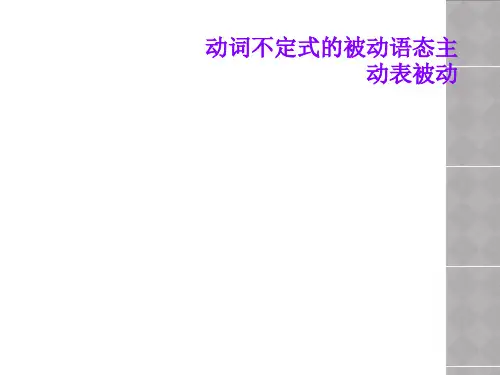
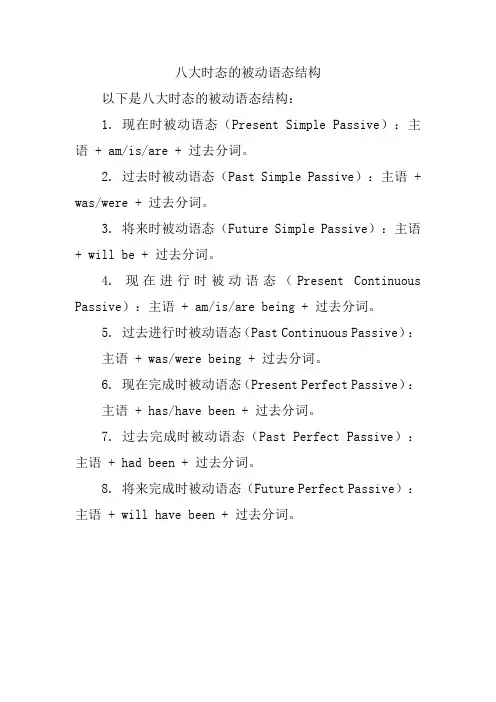
八大时态的被动语态结构
以下是八大时态的被动语态结构:
1. 现在时被动语态(Present Simple Passive):主语 + am/is/are + 过去分词。
2. 过去时被动语态(Past Simple Passive):主语 + was/were + 过去分词。
3. 将来时被动语态(Future Simple Passive):主语+ will be + 过去分词。
4. 现在进行时被动语态(Present Continuous Passive):主语 + am/is/are being + 过去分词。
5. 过去进行时被动语态(Past Continuous Passive):
主语 + was/were being + 过去分词。
6. 现在完成时被动语态(Present Perfect Passive):
主语 + has/have been + 过去分词。
7. 过去完成时被动语态(Past Perfect Passive):主语 + had been + 过去分词。
8. 将来完成时被动语态(Future Perfect Passive):主语 + will have been + 过去分词。
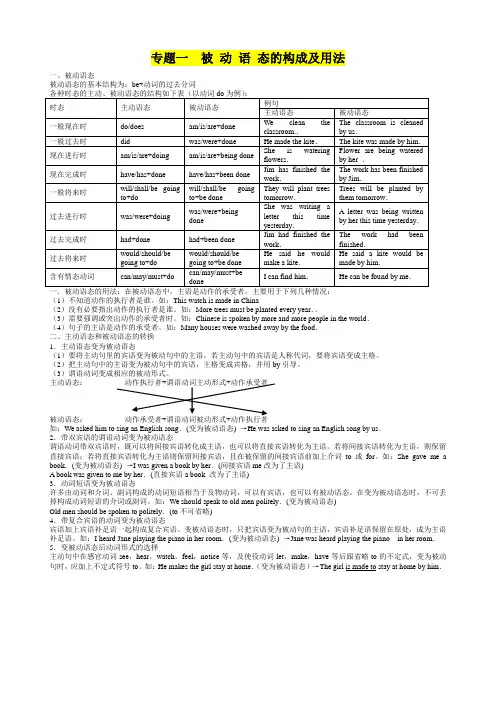
专题一被动语态的构成及用法一、被动语态被动语态的基本结构为:be+动词的过去分词(1)不知道动作的执行者是谁。
如:This watch is made in China(2)没有必要指出动作的执行者是谁。
如:More trees must be planted every year.。
(3)需要强调或突出动作的承受者时。
如:Chinese is spoken by more and more people in the world.(4)句子的主语是动作的承受者。
如:Many houses were washed away by the food.二、主动语态和被动语态的转换1.主动语态变为被动语态(1)要将主动句里的宾语变为被动句中的主语,若主动句中的宾语是人称代词,要将宾语变成主格。
(2)把主动句中的主语变为被动句中的宾语,主格变成宾格,并用by引导。
(3)谓语动词变成相应的被动形式。
主动语态:动作执行者+谓语动词主动形式+动作承受者被动语态:动作承受者+谓语动词被动形式+动作执行者如:We asked him to sing an English song.(变为被动语态) →He was asked to sing an English song by us.2.带双宾语的谓语动词变为被动语态谓语动词带双宾语时,既可以将间接宾语转化成主语,也可以将直接宾语转化为主语。
若将间接宾语转化为主语,则保留直接宾语;若将直接宾语转化为主语则保留间接宾语,且在被保留的间接宾语前加上介词to或for。
如:She gave me a book.(变为被动语态) →I was given a book by her.(间接宾语me改为了主语)A book was given to me by her.(直接宾语a book 改为了主语)3.动词短语变为被动语态许多由动词和介词、副词构成的动词短语相当于及物动词,可以有宾语,也可以有被动语态。
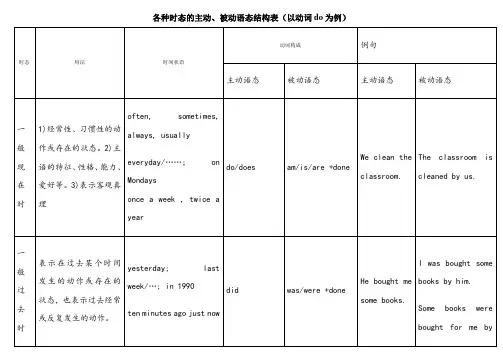
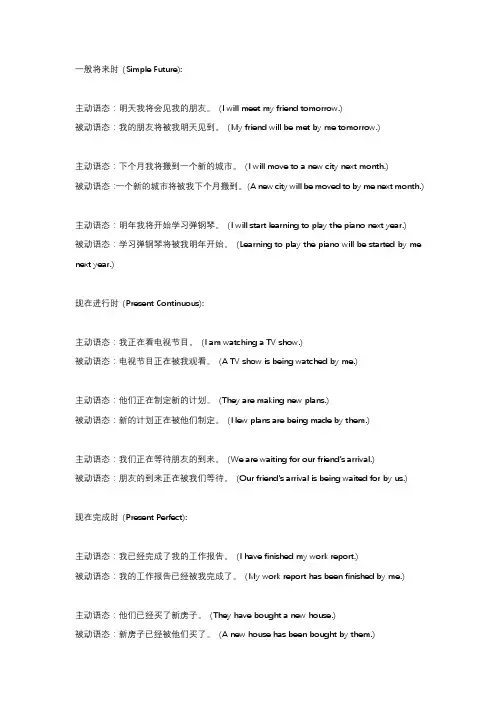
一般将来时(Simple Future):主动语态:明天我将会见我的朋友。
(I will meet my friend tomorrow.)被动语态:我的朋友将被我明天见到。
(My friend will be met by me tomorrow.)主动语态:下个月我将搬到一个新的城市。
(I will move to a new city next month.)被动语态:一个新的城市将被我下个月搬到。
(A new city will be moved to by me next month.)主动语态:明年我将开始学习弹钢琴。
(I will start learning to play the piano next year.)被动语态:学习弹钢琴将被我明年开始。
(Learning to play the piano will be started by me next year.)现在进行时(Present Continuous):主动语态:我正在看电视节目。
(I am watching a TV show.)被动语态:电视节目正在被我观看。
(A TV show is being watched by me.)主动语态:他们正在制定新的计划。
(They are making new plans.)被动语态:新的计划正在被他们制定。
(New plans are being made by them.)主动语态:我们正在等待朋友的到来。
(We are waiting for our friend's arrival.)被动语态:朋友的到来正在被我们等待。
(Our friend's arrival is being waited for by us.)现在完成时(Present Perfect):主动语态:我已经完成了我的工作报告。
(I have finished my work report.)被动语态:我的工作报告已经被我完成了。
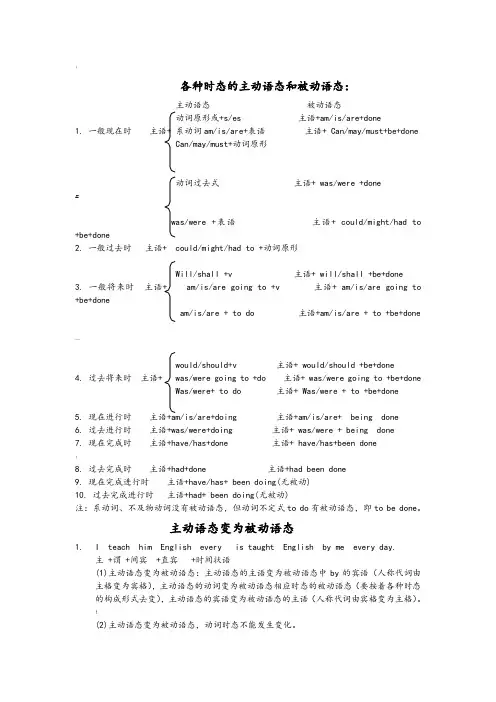
;各种时态的主动语态和被动语态:主动语态被动语态动词原形或+s/es 主语+am/is/are+done1. 一般现在时主语+ 系动词am/is/are+表语主语+ Can/may/must+be+doneCan/may/must+动词原形动词过去式主语+ was/were +done&was/were +表语主语+ could/might/had to+be+done2. 一般过去时主语+ could/might/had to +动词原形Will/shall +v 主语+ will/shall +be+done3. 一般将来时主语+ am/is/are going to +v 主语+ am/is/are going to+be+doneam/is/are + to do 主语+am/is/are + to +be+done—would/should+v 主语+ would/should +be+done4. 过去将来时主语+ was/were going to +do 主语+ was/were going to +be+doneWas/were+ to do 主语+ Was/were + to +be+done5. 现在进行时主语主语+am/is/are+ being done6. 过去进行时主语+was/were+doing 主语+ was/were + being done7. 现在完成时主语+have/has+done 主语+ have/has+been done;8. 过去完成时主语+had+done 主语+had been done9. 现在完成进行时主语+have/has+ been doing(无被动)10. 过去完成进行时主语+had+ been doing(无被动)注:系动词、不及物动词没有被动语态,但动词不定式to do有被动语态,即to be done。
主动语态变为被动语态1.I teach him English every is taught English by me every day.主 +谓 +间宾 +直宾 +时间状语(1)主动语态变为被动语态:主动语态的主语变为被动语态中by的宾语(人称代词由主格变为宾格),主动语态的动词变为被动语态相应时态的被动语态(要按着各种时态的构成形式去变),主动语态的宾语变为被动语态的主语(人称代词由宾格变为主格)。
被动语态句子结构被动语态的句子是以“动词+过去分词”的形式来表达,如果要特别强调动作或行为的执行者时,句子后面需接by~,译为“被(由)……”。
1、被动语态的句型肯定句:主语+be +过去分词+(by~).否定句:主语+be not +过去分词+(by~).一般疑问句:Be +主语+过去分词+(by~)?特殊疑问句:疑问词+be +主语+过去分词+(by~)?被动语态的时态是由be的时态决定的,be是什么时态,全句就是什么时态,be动词后面的过去分词不变。
2、被动语态的十种时态以动词give为例,其被动语态的各种时态构成如下:(1)一般现在时例:History is made by the people.历史是人民创造的。
(2)一般过去时例:These new cars were made in Tianjing in 1994.这些新车是1994年在天津生产的。
(3)一般将来时例:Li Ming will be asked to attend the lecture.李明将被邀请参加讲座。
(4)现在进行时例:A new railway is being built.一条新铁路正在修建。
(5)过去进行时例:The roads were being widened.路那时正在加宽。
(6)现在完成时例:He has been sent to work in Shanghai.他已经被派往去上海工作了。
(7)过去完成时例:A new hotel had been built when I got there.我到那儿时,一座新旅馆已经建好了。
(8)过去将来时例:He said a new hotel would be built in two months.他说两个月后新旅馆就会建好了的。
3、被动语态的否定句和疑问句例:English is not used in European countries.欧洲国家不使用英语。
一. 概念:表示动作与主语之间是被动关系的句子是被动语态。
二. 主动语态与被动语态之间如何转换last summer →主动语态状语That factory was visited by us last summer →被动语态主语谓语宾语状语批注:主动,主动,主去动;被动,被动,主被动。
三.各种不同时态的主动语态与被动语态的对比各种时态的主动、被动语态的结构如下表(以动词do为例)具体用法:1 带双宾语的谓语动词变为被动语态① 谓语动词带双宾语时,既可以将间接宾语转化成主语,也可以将直接宾语转化成主语;② 若将间接宾语转化成主语,则保留直接宾语;③ 若将直接宾语转化成主语则保留间接宾语,且在被保留的间接宾语前加上介词to 或for ;She gave me a book. (变为被动语态)I was given a book by her.(间接宾语me 改为了主语)A book was given to me by her.(直接宾语a book 改为了主语)He often tells us interesting stories . (主动语态)⎭⎬⎫.him by us to told often are stories g Interestin .him by stories g interestin told often are We (被动语态 2动词短语变为被动语态许多由不及物动词和介词、副词构成的动词短语相当于及物动词在变为被We should speak to old men politely.Old men should be spoken to politely.3 to 的“前世今生”主动语态,某些动词后带有复合宾语,即宾语和宾语补足语,复合宾语由动词不定式充当,to 被省略,被动,to 还原。
eg. I often hear her sing this popular song .(主动语态)She is often heard to sing this popular song .(被动语态)Someone saw a stranger walk into the building.可改为A stranger was seen to walk into the building.▲ 有这种用法的常用动词有:5.初中阶段不使用被动语态的情况A.系动词无被动The dish tastes delicious. The apple smells sweet.B.某些说明名词本身性质的动词。
被动语态一、被动语态的构成✧基本结构为:be +动词的过去分词✧各种时态的主动、被动语态的结构:1. 一般现在时- 主动语态:主语+ 动词原形/三单形式- 被动语态:主语+ am/is/are + 过去分词- 例如:- 主动:I make a kite.(我做一个风筝。
)- 被动:A kite is made by me.(一个风筝被我做。
)2. 一般过去时- 主动语态:主语+ 过去式- 被动语态:主语+ was/were + 过去分词- 例如:- 主动:He made a kite.(他做了一个风筝。
)- 被动:A kite was made by him.(一个风筝被他做了。
)3. 一般将来时- 主动语态:主语+ will + 动词原形- 被动语态:主语+ will be +过去分词- 例如:- 主动:He will make a kite.(他将要做一个风筝。
)- 被动:A kite will be made by him.(一个风筝将被他做。
)4.现在进行时- 主动语态:主语+am/is/are doing- 被动语态:主语+ am/is/are + being+过去分词- 例如:- 主动:I am cleaning the room now.(我现在正在打扫房间。
)- 被动:The room is being cleaned by me now.(房间现在正在被打扫。
)5.过去进行时- 主动语态:主语+ was/were doing- 被动语态:主语+ was/were +being+过去分词- 例如:- 主动:He was writing a letter this time yesterday.(昨天的这个时候他正在写信。
)- 被动:A letter was being written by him this time yesterday.(昨天的这个时候一封信正在被他写。
)6.现在完成时- 主动语态:主语+ have/has + 过去分词- 被动语态:主语+ have/has + been+过去分词- 例如:- 主动:Tom has finished the work.(Tom已经完成了工作。
各种情况的主动语态和被动语态一般现在时态(主2被3)1.d o/does→am done/is done/are done 一般过去时态(主1被2)2.d id(规则变化4)→was done/were done现在进行时态(主3被3)3.a m doing/is doing/are doing→am being done/is being done/are being done一般将来时态(主4被4)4.w ill do/am going to do/is going to do/are going to do→ will be done/am going to be done /is going to be done/are going to be done现在完成时态(主2被2)5.h ave done/has done6.情态动词+do过去完成时态(主1被1)7.h ad done→had been done过去将来时态(主3被3)8.w ould do/was going to do/were going to do→would be done /was going to be done/were going to be done过去进行时态(主2被2)9.w as doing/were doing→was being done/were being done 不定式的(主1被1)10.to do →to be done特殊情况:1.主动接原形,被动要加to;make sb do sth→sb be made to do sth see sb do sth→sb be seen to do sthhear sb do sth→sb be heard to do sth help sb do sth→sb be helped to do sth 2.接双宾的动词,变被动有两种情况:sb be given sth/sth be given to sbsb be made sth/sth be made for sb下列动词常用介词to:give, lend, offer, pass, send, show, tell等。
组成例句用法状主被主被一般1) 常性、性的作或存在的often, sometimes, always, usuallyWe clean the The classroom is cleaned by在状。
2) 主的特点、性格、能力、everyday/ ⋯⋯ ;on Mondays do/does am/is/are +done.好等。
3) 表示客真谛once a week , twice a yearI was bought some books by 一般表示在去某个生的作或yesterday; last w eek/ ⋯ ; in 1990He bought me some him.去存在的状,也表示去常或反did was/were +doneten minutes ago just now books.Some books were bought for me 复生的作。
by him.在1) 表示此现在或段正在行now, these days 等或当句中含有 look,She is watering the The flowers are being made byam/is/are +doing am/is/are + being + done行或持的作listen 之的示意flowers.her.this time yesterday, at that time,I was planting trees去表示在去某一刻或去某一Trees were being planted by me then, at ten yesterday, from7:00 to was/were +doing was/were + being +done this time行段正在行的作this time yesterday.9:00 last night yesterday .will/shall + do will/shall be + done一般tomorrow; next week We will discuss this 表示未来要生的作或存在的状am/is/are going to +am/is/are going to be +This question will be 将来in a few days question in classdo done discussed in class tomorrow.in 2021tomorrow.am/is/are + doing am/is/are being done去表示从去某一看将要生的would/should + do would/should be + done He said he wouldHe said the work would be 将来作或存在的状,常用在从was/were going to+ do was/were going to be +done finish the work thefinished the next day.句中was/were + doing was/were being + done next day.1〕表示去生的作或事情在在的影响和生的果. 它的, yet, ever, never, just, before等They have made theThe boy has been made to stop 完成是去的作同在的系。